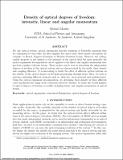Files in this item
Density of optical degrees of freedom : intensity, linear and angular momentum
Item metadata
| dc.contributor.author | Mazilu, Michael | |
| dc.contributor.editor | Andrews, DL | |
| dc.contributor.editor | Galvez, EJ | |
| dc.contributor.editor | Gluckstad, J | |
| dc.date.accessioned | 2014-09-03T14:01:03Z | |
| dc.date.available | 2014-09-03T14:01:03Z | |
| dc.date.issued | 2014-02-25 | |
| dc.identifier | 145508505 | |
| dc.identifier | f0a3c2bb-9737-4404-ad85-78405de3a84b | |
| dc.identifier | 000338075400014 | |
| dc.identifier | 84901644069 | |
| dc.identifier | 000338075400014 | |
| dc.identifier.citation | Mazilu , M 2014 , Density of optical degrees of freedom : intensity, linear and angular momentum . in DL Andrews , EJ Galvez & J Gluckstad (eds) , Complex Light and Optical Forces VIII . vol. 8999 , Proceedings of SPIE , vol. 8999 , SPIE , Bellingham , Conference on Complex Light and Optical Forces VIII , Canada , 4/02/14 . https://doi.org/10.1117/12.2039772 | en |
| dc.identifier.citation | conference | en |
| dc.identifier.issn | 0277-786X | |
| dc.identifier.uri | https://hdl.handle.net/10023/5332 | |
| dc.description.abstract | For any optical system, optical eigenmodes describe solutions of Maxwells equations that are orthogonal to each other. In their simplest free space form, these modes correspond, for example, to Bessel, Laguerre-Gaussian or Hermite-Gaussian beams. However, the orthogonality property is not limited to the intensity of the optical field but more generally the optical eigenmode decomposition can be applied to the linear and angular momentum arising from complex coherent beams. These modes can be seen as describing the independent degrees of freedom of the optical system and are characterized by the mode, their density and coupling efficiency. It is interesting to study the effect of different optical systems on the density of the optical degrees of freedom propagating through them. Here, we look at systems containing different elements such as: dielectric, meta-material and random lenses. Using the optical eigenmode decomposition, we determine their density in these different cases and discuss the origin of the variations observed. Further, we study the overall number of optical degrees of freedom accessible including linear and angular momentum of optical beams. | |
| dc.format.extent | 6 | |
| dc.format.extent | 601340 | |
| dc.language.iso | eng | |
| dc.publisher | SPIE | |
| dc.relation.ispartof | Complex Light and Optical Forces VIII | en |
| dc.relation.ispartofseries | Proceedings of SPIE | en |
| dc.subject | Optical eigenmodes | en |
| dc.subject | Structured illumination | en |
| dc.subject | Optical degrees of freedom | en |
| dc.subject | QC Physics | en |
| dc.subject.lcc | QC | en |
| dc.title | Density of optical degrees of freedom : intensity, linear and angular momentum | en |
| dc.type | Conference item | en |
| dc.contributor.institution | University of St Andrews. School of Physics and Astronomy | en |
| dc.identifier.doi | https://doi.org/10.1117/12.2039772 |
This item appears in the following Collection(s)
Items in the St Andrews Research Repository are protected by copyright, with all rights reserved, unless otherwise indicated.

